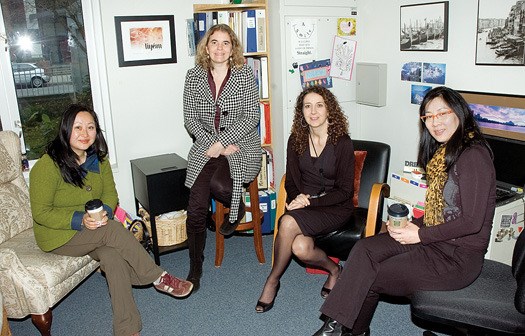On Drake Street, steps away from the water, there is a short crosswalk connecting Elsie Roy Elementary School to the Roundhouse Community Centre. Before, during, and after class, students from the Yaletown school make the trip between these two buildings-to attend a dance class, to wait for their parents to pick them up, to just hang out during the noon hour.
Volunteers from the Roundhouse use the route to visit the school grounds daily-to meet with the schools administrators and teachers, to walk younger students back from activities, to eat lunch in David Lam Park, which doubles as Elsie Roys playground.
Of course, its just a crosswalk. But the buildings it links are pillars in the Yaletown community, and their co-operation is one example of how a mid-sized public elementary school has benefited from partnering with the businesses and groups that share its dense, urban neighbourhood.
The eight-year-old school is perhaps best known as that school where parents used to camp out overnight in the rain to ensure their kids admittance. (Its since moved to a lottery system-the principal, Rosa Fazio, says the camp-out method was unfair.) There are an estimated 3,000 children living in the downtown core, according to the 2006 census, and Elsie Roy was the first inner-city elementary school to be built in Vancouver since 1975 (the next one, near International Village, is in the planning stages; Fazio says it is being mirrored after Elsie Roys model).
Right now, the school holds 355 students, but four new classrooms have just been finished (classrooms that a small group of students helped decorate), which means that next year, that number will grow to 420.
Were full, we are over full, says Fazio. The hope is the International Village will be built and theyll be able to take some of the kids.
The waitlist is ever-present, says Fazio (known endearingly as Miss Rosa to the students). And no wonder-not only is it catering to a large surrounding population, but this is a public school that boasts interactive whiteboards, 60 iPads for student use (thanks primarily to one of their community partners, the Yaletown Lions Club), the Middle Years Baccalaureate program, wi-fi everywhere, and the means to provide inclusive, personalized learning in a multi-cultural, urban setting.
Its this multi-cultural setting in a vertical neighbourhood that the parents I spoke to at Elsie Roy were most fond of. Many of the families live in the surrounding condos and there is no dominant cultural group.
Were living in a community where everybody knows everybody, you see the same faces, you feel comfortable-you actually feel quite safe, says Emerald Yeh, whose daughter is in Grade 5. Another parent, Sue Bai, bought a house in Port Moody when her daughter was first born, but her family ultimately moved back to Yaletown because they felt isolated and missed living in a walkable neighbourhood.
The central location also places the school in a position that allows them to benefit from the surrounding businesses and community groups. The Roundhouse is the most obvious partner (its often referred to as the schools other half), but more than 20 other businesses and six non-profits also support their neighbourhoods school. Concord Pacific has financed learning initiatives to the tune of over $40,000 throughout the years, and Allen Financial, a life insurance company thats been in business in Yaletown for 25 years, is working on a series of videos promoting the schools connections in the community.
How do they get these sponsors? Fazio and the PAC go out and ask. Having worked in 10 schools over the last 22 years, Fazio recognizes her school is in a fortunate position some schools have to fundraise for the basics, while Elsie Roys fundraising efforts focus on the instructional piece of the educational puzzle, what she describes as the and more.
Theres a strong commitment from the staff at Elsie Roy and the staff at the Roundhouse to really work together, says Denise Johnson, a Vancouver School Board director of instruction who works with Elsie Roy. There are other schools in the district that have strong community ties, such as Strathcona Elementary, which also shares grounds with their neighbourhood community centre.
The school board has just published its sectoral review, Our Future (available online), part of which looks at how schools are working with their community partners and identifying who they can work with in the future.
Theres a real interest, willingness and excitement about aiding and increasing our community partnerships, she says, noting that the interest goes both ways. I think everyones starting to realize the benefits of us working together.
When I visited Elsie Roy during the morning recess late last week, some of the older kids were lounging about in the front office - rocking back and forth on swivel chairs, chatting with staff members, asking their parents (who are members of the schools PAC administration, and often on school grounds) for a dollar.
This somewhat unconventional scene, these three groups interacting so casually and comfortably, reminds me of something Fazio had said moments before: We expect parents to be part of the learning experience. Were one third responsible as the school, your child is one third responsible, and as parents youre one third responsible, she says. We have to break down the walls inside the school, and outside of it, and work with people.



